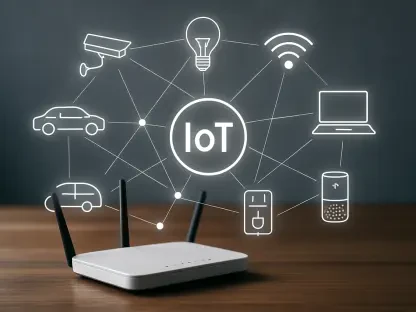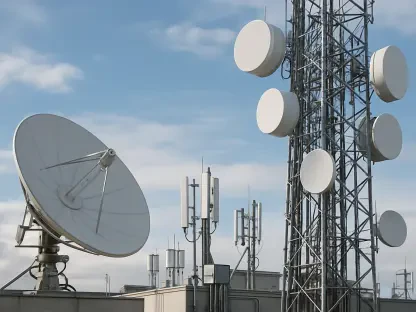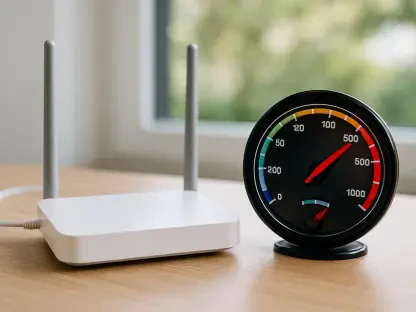Imagine a world where billions of devices, from smart city sensors to agricultural monitors, communicate seamlessly over vast distances with minimal power consumption, driving efficiency and innovation across industries. This is the promise of Low Power Wide Area Network (LPWAN) technology, a cornerstone of the Internet of Things (IoT) ecosystem that is poised for remarkable expansion over the next decade. As industries increasingly adopt IoT solutions to optimize operations and reduce costs, LPWAN stands out for its ability to provide long-range connectivity with low energy demands, making it ideal for applications like asset tracking and industrial automation. A recent comprehensive report on the global LPWAN market projects substantial growth from now through 2035, fueled by technological advancements and rising demand for connected solutions. This surge highlights the critical role LPWAN will play in shaping the future of digital transformation, offering a glimpse into a highly interconnected and efficient global landscape.
Driving Forces Behind LPWAN Expansion
The momentum behind the LPWAN market’s growth is largely attributed to the escalating demand for IoT applications across diverse sectors such as smart cities, agriculture, and logistics. This technology’s unique ability to enable long-range communication with minimal power usage makes it a preferred choice for connecting battery-operated devices over expansive areas. Key industry players are pouring significant resources into research and development to refine LPWAN solutions, introducing innovations that enhance connectivity and reliability. These advancements are expected to broaden the scope of applications, further accelerating market adoption. Additionally, the push for digitalization globally is creating fertile ground for LPWAN technologies to thrive, as governments and enterprises alike seek efficient ways to manage sprawling networks of devices. Over the coming years through 2035, this convergence of demand and innovation is set to propel the market to new heights, establishing LPWAN as a vital component of modern infrastructure.
Another critical driver of LPWAN growth lies in the strategic collaborations shaping the industry’s landscape. Major companies are engaging in mergers, acquisitions, and partnerships to strengthen their market positions and expand their technological capabilities. Such alliances enable firms to pool resources, share expertise, and accelerate the deployment of advanced LPWAN solutions tailored to specific industry needs. These cooperative efforts are particularly crucial in a market characterized by rapid technological evolution, where staying ahead requires constant adaptation. Beyond corporate strategies, the increasing governmental support for smart technology initiatives, especially in regions prioritizing urban and industrial modernization, is amplifying market opportunities. This blend of private innovation and public policy support underscores the robust foundation for LPWAN’s projected expansion through the next decade, promising a transformative impact on global connectivity.
Competitive Dynamics and Market Challenges
The LPWAN market is marked by a highly competitive environment, with a handful of established players holding significant sway over the industry. Companies based in regions like Europe and North America dominate due to their substantial investments in cutting-edge technologies and extensive market presence. This consolidation creates steep barriers for new entrants, who must navigate a landscape where innovation and scale are paramount to gaining a foothold. The competitive outlook reveals a focus on continuous improvement, with leading vendors prioritizing the development of robust, scalable solutions to maintain their edge. As the market evolves through 2035, the intensity of this competition is expected to drive further advancements, benefiting end-users with more reliable and efficient LPWAN offerings. However, the dominance of major players also underscores the need for smaller firms to identify niche opportunities to carve out their space in this dynamic sector.
Despite the optimistic growth trajectory, the LPWAN market faces notable challenges that could temper its expansion. Fluctuations in the availability and pricing of raw materials pose significant risks, potentially disrupting production timelines and increasing costs for manufacturers. These economic uncertainties require companies to adopt flexible strategies to mitigate potential setbacks and ensure steady supply chains. Additionally, external disruptions, such as those experienced during global crises like the COVID-19 pandemic, have exposed vulnerabilities in market dynamics, affecting both demand and operational capacities. While the industry has shown resilience, adapting to such challenges remains a critical focus. The ability to navigate these obstacles will be essential for sustaining growth through the forecast period to 2035, demanding proactive risk management and innovative problem-solving from all market participants.
Regional Trends and Emerging Opportunities
Geographically, the LPWAN market exhibits varied patterns of adoption and growth, with North America and Europe leading as mature markets due to their advanced infrastructure and high demand for IoT solutions. These regions benefit from early investments in smart technologies, positioning them at the forefront of LPWAN implementation in areas like urban planning and industrial automation. Strong regulatory frameworks and technological readiness further support their dominance, ensuring a steady integration of LPWAN into existing systems. However, while these markets are well-established, their growth rates may plateau as saturation approaches, prompting companies to seek differentiation through specialized applications. The focus through 2035 will likely shift toward enhancing existing networks and addressing specific industry pain points, maintaining these regions as critical hubs for LPWAN innovation and deployment.
In contrast, the Asia Pacific region stands out as a hotspot for rapid LPWAN growth, driven by accelerating industrialization and urbanization in countries like China, India, and Japan. Government initiatives promoting smart cities and digital economies are catalyzing the adoption of LPWAN technologies, creating a burgeoning market for connectivity solutions. Meanwhile, Latin America and the Middle East & Africa, though currently smaller in market share, present untapped potential as investments in digital transformation gain momentum. These emerging markets offer unique opportunities for companies willing to tailor solutions to local needs, such as affordable connectivity for rural agriculture or infrastructure monitoring. As the global LPWAN landscape evolves through 2035, the disparity between mature and emerging regions highlights the importance of strategic localization, ensuring that growth is both inclusive and sustainable across diverse economic environments.
Navigating the Future of LPWAN Technology
Reflecting on the journey so far, the LPWAN market has demonstrated remarkable adaptability in overcoming past disruptions, including supply chain hiccups and global economic shifts. Industry stakeholders recalibrated their approaches, focusing on resilience through diversified sourcing and enhanced operational strategies. The response to challenges like the pandemic showcased a collective determination to maintain progress, with many firms pivoting to meet altered demand patterns. This period of adjustment laid a strong groundwork for future stability, proving that the sector could withstand significant headwinds while continuing to innovate. The lessons learned during these times have become invaluable, shaping a more robust framework for tackling upcoming hurdles with confidence and foresight.
Looking ahead, the path to sustained growth in the LPWAN market hinges on actionable strategies that address both current and anticipated challenges. Companies should prioritize building agile supply chains to counter raw material volatility, while investing in technologies that enhance network scalability and efficiency. Collaboration will remain a cornerstone, as partnerships can unlock new markets and drive innovation at a faster pace. For regions with emerging potential, tailoring solutions to local contexts will be key to capturing growth opportunities. As the industry progresses toward 2035, a balanced approach—combining technological advancement with strategic risk management—will ensure that LPWAN continues to redefine connectivity, paving the way for a more integrated and intelligent global ecosystem.









